11 June 2015
12 Men on the Verge of Nervous Breakdown
Round Nine Review of the Final FIDE Grand Prix in Khanty-Mansiysk by GM Sergei Shipov.
The tension goes through the roof. Not being familiar with the sporting aspect of the tournament, it is hard to explain all the silly blunders committed by the chess heavy-weights, the blunders which even players of a candidate master level would have avoided. And yet this happens over and over again.
It is the mental state of chessplayers that has to do with it. They fail to stand up to overstrain and the weight of responsibility. Nervous systems of chessplayers resemble computers that stop responding when overheated.
It is going down into the history of chess and so many thousands of dollars that is at stake. One step in the wrong direction is very likely to be as good as saying farewell to the Candidates Tournament. The very thought of it is undoubtedly going to be in the way for any player, even the most robust one.
In round nine almost all tournament leaders displayed unsteady performance and committed blunders.
Karjakin – Caruana
I think I will refrain from commenting on the incident with triple repetition of moves. It is up to qualified arbiters and lawyers.
I am going to focus purely on the chess content, especially since it has turned out to be so delicious.
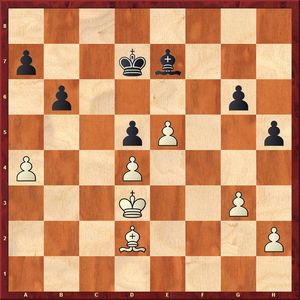
31.a5?
After the game Sergei admitted that out of sheer inertia he went on laboring under the illusion of being better, without having realized the precariousness of his position. A simple 31.h3 with the idea of g3-g4 would have ensured comfortable game for White. However, Black experiences no problems either.
31...bxa5! 32.Bxa5 g5!
Not only has Black managed to create a remote passed pawn, but he has also got the opportunity to fix the weak white pawn on g3. Further development of the struggle creates a strong impression of this position coming from some textbook. The principle of two weaknesses (in the broad sense of the term "weakness") is visible in its classical form.
33.h3 g4 34.hxg4 hxg4 35.Ke3 Bg5+ 36.Kd3 Kc6 37.Bd2 Be7 38.Ke3 Bg5+ 39.Kd3 Be7 40.Ke3 Bf8! 41.Ba5 Bh6+ 42.Kd3 Kd7 43.Bd2 Bf8 44.Ke3 Ke6 45.Ba5 Kf5 46.Kd3 Be7 47.Ke3 Bg5+ 48.Kd3 Ke6
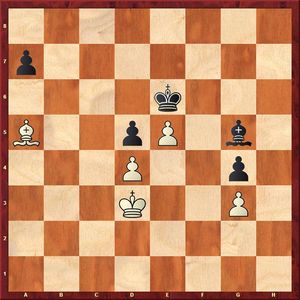
49.Bd2?!
This is a strange concession. Why allow your opponent the possibility of advancing his remote passed pawn?
It yet needs to be clarified how Black could have achieved any progress after 49.Ke2!, for example, 49...a6 (or 49...Be7 50.Kd3 Kf5 51.Ke3 Bg5+ 52.Kd3; or 49...Bc1 50.Bd2 Bb2 51.Kd3) 50.Kd3 Kf5 51.Bb6 Bc1 52.Ba5 Bh6 53.Bd2 Bf8 54.Ba5 etc.
49...Bd8! 50.Ke3 Kf5 51.Bb4?
More accurate here would have been to go for 51.Bc3! a5 52.Kd3 a4 53.Bb4 not allowing the black bishop getting access to a5. After that possible is 53...Bg5 (or 53...Bb6 54.Kc3! Ke4 55.e6 Bxd4+ 56.Kd2 Bf6 57.e7 Bxe7 58.Bxe7 Kf3 59.Bd6=) 54.Ba3! Bh6 (54...Bd8 55.Bb4) 55.Ke2! Bg5 (55...Ke4 56.e6) 56.Kd3=.
51...a5 52.Ba3 a4
Now the black bishop is able to penetrate either to a5 or to с1.
53.Bb4 Bg5+ 54.Kd3 Bc1! 55.Bd2 Ba3 56.Kc3 Be7 57.Bh6

57...a3
In the course of the game there loomed on the horizon a couple of reference positions, which the opponents were striving for in their advanced calculations, although their final evaluation was not all that easy to grasp. For example, after 57...Ke4 58.Bf4 a3 59.Bh6 Bb4 + 60.Kb3 a2 61.Kxa2 Kxd4 62.Kb3 Be7 63.Bf4 Ke4 64.Kc2 Bf8 65.Kd2 Kf5 66.Kd3 Bg7 67.Bd2 (67. Kd4? Ke6) 67...Bxe5 68.Be1. Let us take a look:
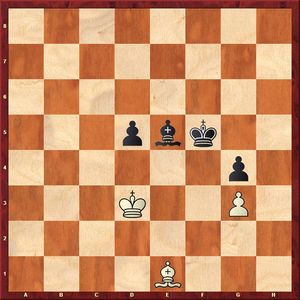
Is Black winning this position? The most likely answer is no.
58.Kb3 Bb4 59.Bf4?
This is a mistake in assigning priorities. White should have supported another pawn: 59.Be3!
59...Ke6?!
This is a very strange move, the idea behind which has yet to be explained.
Correct was 59...Be1!, going after the d4-pawn. For example, 60.Kxa3 Bf2! 61.e6 Bxd4! 62.e7 Bc5+ and Black is winning.
More stubborn was 60.Be3. But in this case the loss of a tempo that happened in the course of maneuvering via Bh6-f4-e3 would become fatal for White: 60...Bxg3 61.Kxa3 Be1 62.Kb3 g3 63.Kc2 Ke4! 64.Bg1 Bb4

Then Black is going to step up pressure, waiting for his opponent to react with e5-e6, upon which he calmly returns with his king to f5 and captures the fugitive pawn. For example, 65.e6 (or 65.Kb3 Bd2 66.Kc2 Bg5 67.Kc3 Kf3 68.e6 Ke4!) 65...Kf3! (rather than immediate 65...Kf5 66.Kd3 Kxe6 67.Ke2=) 66.Kd3 Kg2! 67.Be3 Kf1! (this is an important bypass maneuver) 68.Kc2 Be7 69.Kb3 (69.Kd3 g2 70.Kc2 g1Q 71.Bxg1 Kxg1–+) 69...Ke2! 70.Bg1 Kd3 71.Ka4 Ke4 72.Kb5 Kf5 and the desired goal has been attained.
60.Bc1 (60.Be3!) 60...Be1 61.Be3 Bxg3 62.Kxa3
Judging by Fabiano’s body language over the board he started to realize that winning the g3-pawn was not going to guarantee a victory for him just yet. His eyes were now opened to previously unexpected nuances...
62...Kf5
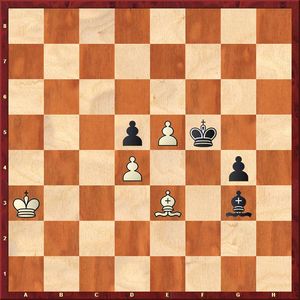
63.Kb4?!
Apparently, Sergei could no longer operate to the full extent of his powers, which is understandable after what has happened.
White could have escaped with a subtle move 63.Kb3!, when the white king is about to bridge the gap with the kingside on one hand, but is also ready to go for the d5-pawn, if need be. For example, Black gains nothing after 63...Be1 64.Kc2 Ke4 65.Kd1=. Or 63...Bh2 64.Kb4! g3 65.Kc5 Ke6 (65...Ke4 66.e6) 66.Bf4!=.
More interesting was 63...Bh4 64.Kc2 Ke4 65.Kd2 Kf3 66.Kd3 g3 67.e6. Had Black had his king on f1, he would have gained the upper hand. However... 67...Be7 (67...Kg2 68.Ke2!) 68.Kd2 Bd6 69.Kd3 Bb4 70.Bg5 g2 71.Be3 Be7 72.Bg1 (72.Kd2? Bg5) 72...Bg5
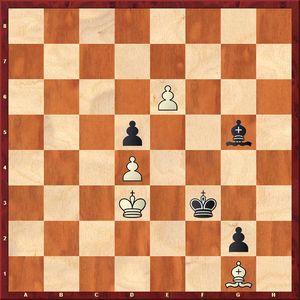
73.Kc3! Ke2 74.Kb4 Be7+ (74...Kf1 75.Bh2) 75.Kb5 Kf1 76.Bh2 (also nice is 76.Be3 Bg5 77.Bxg5! g1Q 78.e7=) 76...Bd6 77.Kc6 Bxh2 78.e7 g1Q 79.e8Q, and the d5-pawn is pretty much gone.
63...Be1+ 64.Kc5 Ke6 65.Bf4 g3 66.Bg5! Kf5
66...Bf2 was intended to be met by 67.Bh4!
67.Bf4!

This is an elegant resource. The fate of the bishop can be neglected for the sake of queening a pawn.
67...Ke6
Fruitless is 67...g2 68.Be3 Ke6 69.Bg1 Bd2 70.Bf2 Bf4 71.Bg1 Bg3 72.Kc6=.
68.Bg5 Kf5 69.Bf4 Kxf4!
This is a last resort, but quite a serious one.
70.e6 g2 71.e7 Bb4+!
Of course not 71...g1Q 72.e8Q because Black cannot keep his last pawn alive.
72.Kxb4 g1Q 73.e8Q Qxd4+ 74.Ka5
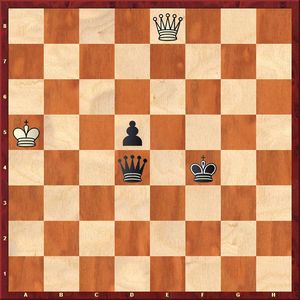
Black is winning in this position. The Nalimov tablebases return the verdict of “mate in 59 moves”. Only it is human chessplayers who are facing each other over the board, not chess engines.
74...Qe5?!
Caruana misses the win with his very first move.
74...Qc3+ suggested itself in order to restrict the white king, but after 75.Ka4! d4? 76.Qf7+ Ke3 77.Qe7+ Kd2 78.Qg5+ Qe3 79.Qg2+ Qe2 80.Qg5+ Kc3 81.Qa5+! Kc2 82.Qc5+ the black king would fail to find shelter against checks.
The engine insists on the cute move 74...Kf3!!, informing us that this is the shortest way home to victory. There are very few players, if any, to find this shortcut.
On the other hand the idea behind the move 74...Qe4! is quite comprehensible as Black clears the road for his pawn, without letting the opponent’s king through the fourth rank. Well, whether the Italian in this case would have managed to bring his advantage home had remained to be seen. Let us have a look at one simple example: after 75.Qf7 + Ke3 76.Qa7 + it would be extremely difficult to refrain from pushing the pawn forward with 76... d4, and exactly this move would have let go of the victory in view of 77.Ka4!!
These are not human lines, after all.
75.Qc8 d4+ 76.Kb4! d3 77.Qh3 Ke4 (77...d2 78.Qh2+!) 78.Qh1+! Kd4 79.Qa1+ Kd5 80.Qxe5+! Kxe5 81.Kc3

The white king is just in time.
81...Ke4 82.Kd2 Kd4 83.Kd1 Kc3 84.Kc1 d2+ 85.Kd1 Kd3 Draw.
I hope that my immature analytical lines and findings will be completed and made more precise by other analysts as well. This is one of the most interesting bishop endings and is definitely worth it.
It is quite surprising that no blood was drawn in the following dramatic encounter.
Jakovenko – Gelfand
1.e4 c5 2.Nf3 d6 3.d4 cxd4 4.Nxd4 Nf6 5.Nc3 a6 6.h3 e5 7.Nde2 h5 8.g3 b5 9.Nd5 Nbd7 10.Bg5 Bb7 11.Nec3 Rc8 12.Bg2 Be7 13.Nxe7 Qxe7 14.0–0 Qe6 15.Re1 b4 16.Nd5 Bxd5 17.exd5 Qf5 18.Bd2 Rxc2 19.Rc1 Rxc1 20.Qxc1 Nc5 21.Bxb4 Nd3 22.Qc6+ Qd7 23.Qa8+ Qd8 24.Qc6+
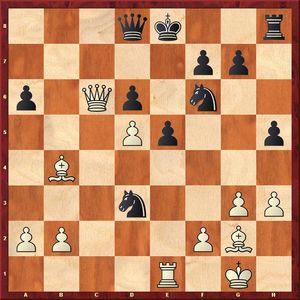
The perpetual check should have crowned this brief but logical game. However, Boris made up his mind to continue fighting, too much for his own good...
24...Nd7??
Apparently he got it all wrong, while trying to resurrect in his mind some analyzed but forgotten lines, because the very first opponent’s move really took him by surprise.
25.Re4!
This move is as natural as the nature itself: one piece sidesteps being en prise while lending support to his fellow.
25...f5
Starting from this position White failed to profit from multiple occasions to finish the game in a simple and quick way.
26.Rc4
For example, 26.Bxd6! fxe4 27.Bxe4 Rh6 28.Bxd3+–.
26...e4 27.Qxa6
Or 27.Bxd6 Rh6 28.Qxa6+–. I am not going to bother you with such simple winning lines any longer...
27...Nxb4 28.Qxd6 Nd3 29.Qe6+ Kf8 30.Qxf5+ Kg8 31.Qe6+ Kf8 32.Qd6+ Kg8 33.Qe6+ Kf8 34.Qxe4 N3e5 35.Qf5+ Kg8 36.d6 Rh6 37.Re4 h4 38.Rxh4 Rxh4 39.gxh4 Qxh4 40.Bd5+ Kh8 41.Kh1 Qh6 42.f4 g6 43.Qe6 Qf8

Having negotiated the unnerving experience of the time trouble, Jakovenko emerged with a substantial advantage. Lengthy contemplations failed to serve him any good, however.
44.Bb3?!
This is too subtle an idea. Both rook pawn moves were equally good to win the game. Namely, 44.a4 with a simple idea to push the pawn all the way up to promotion, and 44.h4!? that contained the idea of securing more escape routes for his king and to prevent the pawn stab that his opponent managed to carry out during the game.
44...g5!
Losing the game were 44...Qa8+ 45.Qd5 or 44...Nd3 45.Qxg6 Nxf4 46.Qg5+-.
45.f5! Nd3?
Gelfand must have been convinced in the hopelessness of his position and could not bring himself to believe that after the queen exchanges his knights would be able to put up a fight against the bishop.
Meanwhile, after 45...Kg7! (now that there is no more mating threat the queen is free to do as she pleases) I could not find any clear winning path for White. Perhaps it is not there at all: 46.Qe7 + Qxe7 47.dxe7 Nf6 48.Bd5.

During online broadcasting we analyzed 48...Nf7, but after 49.a4 Nd6 50.Bf3! Kf7 51.a5 Kxe7 it is the marathon of the white king that represents a danger for Black: 52.Kg2! (weaker is 52.a6 Nc8 53.Kg2 Kd6) 52...Kd7 53.a6 Nc8 54.Kf2 Kc7 55.Ke3 Kb6 56.Kd4 Kxa6 57.Ke5 etc.
Therefore, more precise is 48...Ne8! 49.a4 Kf6 50.a5 Kxe7 51.a6 Nc7 52.a7 Nd3 53.b3 Kf6 54.Kh2 Kxf5 55.Kg3 Ke5 56.Bg2 (56.Bf3 Kd4) 56...Nf4 57.a8Q Nxa8 58.Bxa8
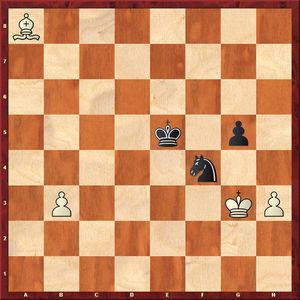
58...Kd4! 59.Bc6 Kc3 60.Ba4 Ne2+ 61.Kg4 Ng1 and White cannot improve his position any further. Draw.
46.Qxd7 Qa8+ 47.Kg1 Nf4 48.Kf2
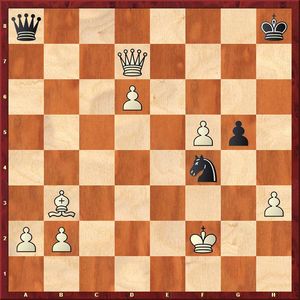
The white king is prepared to start his marathon from f2 via b6-d8 to e7, winning the game. Boris decides to give a try to his last chance, as if of sheer hopelessness.
48...g4!
The point is that the black king has no legal moves, therefore Black pins his hopes on parting ways with all his pieces in order to end up being stalemated. I must admit that I was more than sure that this was never going to happen, but…
49.hxg4??
Strangely, Dmitry was not under any sort of time pressure. He went on thinking and calculating lines in an unhurried manner. He was well aware of the stalemate possibility, but nevertheless failed to single out this brief line that finally took place in the game.
White should have obviously avoided taking the pawn. Well, but what to do next? Premature is 49.Qe7? in view of 49...Qf3+ 50.Ke1 Qg3+! 51.Kd2 Qd3+ when the white king cannot hide himself from checks.
Therefore, he needs to run past the suicide-minded black pieces straight into Sokolniki to seek shelter in this spacious facility.
The arising lines are quite extensive, but their overall tendency is quite comprehensible. For example, 49.Ke3 Qf3+ 50.Kd4 Qf2+ (50...gxh3 51.Qd8+ Kg7 52.Qg5+ Kh7 53.Qh4+ Kg7 54.f6+! Kg6 55.Bc2+ Kf7 56.Qh7+ Kxf6 57.Qe7#) 51.Ke4 Qf3+ 52.Ke5 Qe3+ 53.Kf6 Qd4+ 54.Kf7 Qg7+ 55.Ke8+-.
More precise and accurate would be 49.Kg3! gxh3 (49...Qf3+ 50.Kh4 Qf2+ 51.Kg5 Nxh3+ 52.Kg6 Nf4+ 53.Kf7+-) 50.Qe7 Qg2+ 51.Kxf4! (51.Kh4? h2!) 51...Qf2+ 52.Kg5 Qg3+ 53.Kh6 Qf4+ 54.Kg6 Qg4+ 55.Qg5+-.
49...Qg2+ 50.Ke3 Nd5+!
This is the unforeseen maneuver.
Checking with queen would have failed to save Black: 50...Qg1+ 51.Ke4! Qg2+ 52.Kd4 Qd2+ (52...Qxb2+ 53.Kc4 Qe2+ 54.Kc5 Nd3+ 55.Kb6 Qe3+ 56.Kc7 Qa7+ 57.Kd8 Qb8+ 58.Ke7+-) 53.Kc5! Qa5+ 54.Kc6 Qa6+ 55.Kc7 Nd5+ (55...Qa7+ 56.Kd8 Qb8+ 57.Qc8 Qxd6+ 58.Ke8 Qe5+ 59.Kf7+ Kh7 60.Qc3+-) 56.Kb8 Qb6+ 57.Qb7 Qxd6+ 58.Ka8 Nc7+ (58...Qd8+ 59.Qb8) 59.Ka7 Qc5+ 60.Qb6+-.
51.Kd4
Or 51.Bxd5 Qd2+ 52.Ke4 Qd4+.
51...Qf2+
It appears that White is denied access both to c4 and e4 in view of the black knight forking the white queen. There is no escape from being chased.
52.Kxd5 Qd4+
Quite spectacular perpetual check would have emerged after 53.Kc6 Qb6+ 54.Kd5 Qd4+ 55.Ke6 Qf6+. White played another move, however...
53.Kxd4!
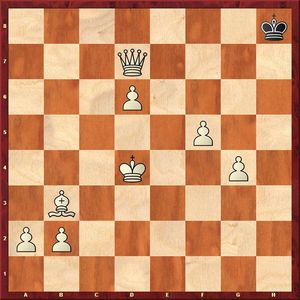
Very few chess games saw the World Title Candidate being so down on material. But even this much material advantage is not enough for a win because it is a stalemate on the board!
In yet another game of one of the tournament’s leaders, a large burden of responsibility was the cause of a sudden “amputation” of the second half of the game.
Dominguez – Vachier-Lagrave
1.e4 c5 2.Nf3 d6 3.d4 cxd4 4.Nxd4 Nf6 5.Nc3 a6 6.f3 e5 7.Nb3 Be6 8.Be3 Be7 9.Qd2 0–0 10.0–0–0 Nbd7 11.g4 b5 12.g5 b4 13.Na4 Nh5 14.Qxb4 d5 15.Qa5 Bxg5 16.Bxg5 Qxg5+ 17.Kb1 dxe4 18.Nd4!N Qf6 19.Nxe6 Qxe6 20.fxe4 Ndf6 21.b3 Nxe4 22.Bc4 Qf5 23.Rhf1 Nf4 24.Bd3 Qg6 25.Rg1 Qf5

The Cuban employed a brilliant opening novelty and succeeded in developing an initiative, but then for some reason made up his mind to refrain from further fighting. He might have attempted to count all the complicated lines till the end, got tired and then had second thoughts about taking any risks.
He should have quickly gone in favor of the self-suggesting 26.Rdf1! without spending much time on any deep calculations. White stood chances of success in the complications to follow. For example, 26...Rad8 (in the case of 26...Rfd8 27.Ka1 Rd4 28.Nc5 Rd5 29.Qb4 Rxc5 30.Bxe4 the a8-rook is going to perish) 27.Ka1 Rd4 (27...Rxd3 28.cxd3 Nf6 29.d4±) 28.Nc5 Rd5 29.b4! (not so clear is 29.Qb4 Rxc5 30.Qxc5 Nxc5 31.Bxf5 g6 with counterplay for Black) 29...Rxc5 30.Qxc5 Nxc5 31.Bxf5 Nce6.

This sharp ending required both players to demonstrate a great deal of accuracy and stamina. Nevertheless, White’s trumps should prevail at the end: 32.Bxe6 Nxe6 33.Kb2 f5 34.Rd1!! e4 (or 34...Nd4 35.a4 f4 36.Rge1 Nf3 37.Re2 Re8 38.c4+-) 35.Rd6 Kf7 36.Re1!, and White goes on pushing forward his pawns.
The game, however, saw a dismal repetition of moves.
26.Rgf1 Qg6 27.Rg1 Qf5 28.Rgf1 Draw.
The game between Grischuk and Nakamura differed from all other games of the round in that it developed uneventfully without any high and low points. Black equalized in the Grunfeld Defense by playing accurately, and a peace agreement symbolized the reasonable outcome of the preceding run of play.
On the contrary, quite interesting developments took place in the games of the tournament tailenders.
However, the term "tailender" is a relative concept. Among such tailenders there is one player who, despite being low on points in the tournament table, still continues fighting for the qualification into the Candidates’ Tournament.
Svidler – Tomashevsky
I believe that it was a huge difference in the motivation of the opponents that became the root cause of the outcome of the game.
1.e4 e5 2.Nf3 Nc6 3.Bb5 a6 4.Ba4 Nf6 5.0–0 Be7 6.Re1 b5 7.Bb3 0–0 8.a4 Bb7 9.d3 d6 10.Nbd2 Na5 11.Ba2 c5 12.Nf1 bxa4 13.Ne3 Bc6 14.Nf5 Bd7 15.N3h4 Kh8 16.f4 Nc6 17.c3 Rb8 18.Rf1 exf4 19.Rxf4 Ne5 20.Nxe7 Qxe7 21.Nf5 Bxf5 22.Rxf5 c4 23.Bxc4 Qa7+
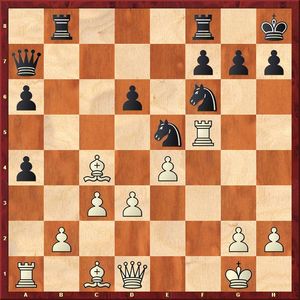
Of course, every talented player takes more pleasure from attacking than from defending. Especially if you play for fun and there is not much at stake. This is the reason of the following gambling move that was played in this position.
24.d4?!
In any other tournament circumstances Peter might have preferred to put up with suffering after 24.Kh1! Nxc4 25.dxc4 Nxe4 26.Qf3, and it is not the easiest of tasks for Black to convert his advantage: 26...Rbe8 (26...Nc5 27.Bf4!; 26...g6 27.Be3 Qe7 28.Bd4+ Kg8 29.Ra5) 27.Be3 (27.Rxa4? Nf2+) 27...Qb7 28.Rxa4 Qxb2 29.Rxf7! Qb1+ 30.Bg1 Kg8 31.Rb4! (31.Rxf8+ Rxf8) 31...Rxf7 (31...Qa1? 32.Rbb7+-) 32.Rxb1 Rxf3 33.gxf3, and White is close to escaping.
24...Nxc4 25.Qf1
White is telegraphing his intentions of sacrificing on f6. However, Black is in time to damage White’s pawn structure.
25...a3! 26.bxa3 Nxe4 27.Qxc4 Rbc8 28.Qd3 Nxc3
White gives back his extra piece to end up being up a pawn with a positional edge.
29.Be3 Rfe8 30.Raf1 f6 31.Ra5 Qb7 32.Rf3 Qb2 33.h3 Ne4 34.Rxa6 d5 35.Ra5 Rc2 36.Qf1 Qa2 37.Kh2 h6 38.Rf5 Rb8
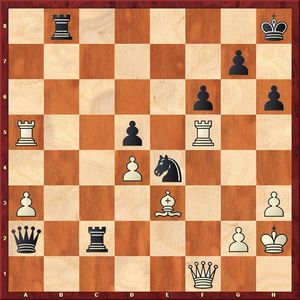
Svidler needed to set up at least one significant trap to try to capitalize on Tomashevsky being in serious time trouble, but he didn’t do it.
39.Raxd5?!
He should have tried 39.Rh5! with the idea of meeting 39...Rxg2+? by 40.Qxg2 Rb2 41.Ra8+ Kh7 42.Rxh6+! gxh6 43.Ra7+ Kh8 44.Ra8+ with the perpetual check.
Black would retain his sizeable advantage via prophylactic 39...Kg8!, although this move would be too difficult to find by Evgeny with just a few seconds on his clock.
39...Rxg2+
This is one possible way. Also winning was 39...Rbb2, but in this case Black was supposed to see that his queen had the f7-square under control from his remote location 40.Rg5 Nxg5 41.Rd8+ Kh7 42.Qf5+ g6 43.Qd7+ Nf7!
40.Qxg2 Rb2 41.Bf2 Nxf2 42.Kg3 Rb3+
Peter resigned in this position. This was a correct decision because after 43.Kh2 Rxh3+ 44.Qxh3 Nxh3+ 45.Kxh3 Qxa3+ 46.Kg2 Qd3 White was not in time to rearrange his rooks comfortably so that they lend support to the passed pawn from behind. For example, 47.Rf3 Qe4 48.Rd8+ Kh7 49.d5 Qe7 50.Ra8 Qe2+ 51.Kg3 Qe5+ and it is all but over.
So, the seven-time Champion of Russia suffered his third defeat in a row. Where and when did it happened last time?
One may jump to the conclusion that this year has so far featured the amazing series of setbacks, creating a visible contrast to the events of the previous year. Remember how in 2014 Caruana, Grischuk, Kramnik and Giri would win many times in a row? And this year, for the first time in his career, Kramnik has suffered three consecutive losses in the tournament in Shamkir, whereas here, in Khanty-Mansiysk a rather sad series was displayed by Vachier-Lagrave and Svidler.
Well, it cannot be perfect every year... However, there are still many months before the end of year 2015. We might witness some change of trends yet.
A surprisingly easy victory by the Russian Dutchman remained in the shadow of the other events of the round.
Giri – Jobava
1. e4!
I have come to believe that any player, even the one who has never played the move that associates itself with the name Ostap Bender, will be more than happy to use it against the Georgian grandmaster, who keeps repeating his rather dubious opening experiments with a surprising consistency. So, Anish could not resist the temptation either. And the course of the game proved him to be right.
1...e6 2.d4 d5 3.Nc3 Nc6 4.e5 Bd7 5.Nf3 a6 6.a3 f6 7.Bd3 fxe5 8.dxe5 Bc5 9.0–0 Nge7 10.Ne2 0–0 11.Nf4 h6

Black is boxed in, being on the receiving end of the attack.
12.c4
Even stronger was 12.b4! Ba7 13.c4 Nd4 14.Be3 or even 14.Ra2!?
12...Nd4 13.Nxd4 Bxd4 14.cxd5
Not every player in the shoes of Giri would have had enough courage to get himself entangled into a pin via 14.Qg4 Bxe5 15.Nxe6, especially because the consequences are rather unclear after 15...Qe8!
14...Nxd5?!
This is inaccuracy. After 14...exd5! 15.Bc2 would not work in view of Bxe5!, whereas in the case of 15.e6 Be8 16.Bc2 c5 17.Qd3 g6! Black would manage to set up reliable defensive formations.
15.Nxd5 exd5 16.Bc2!
Black has problems because the e5-pawn cannot be touched.
16...c5
Unsuccessful is 16...Qh4 17.Be3! (17.g3? Qg4=) 17...Bxe3 18.Qxd5+ Kh8 19.fxe3±.
17.Be3 Qb6 18.Bxd4 cxd4 19.Qd3
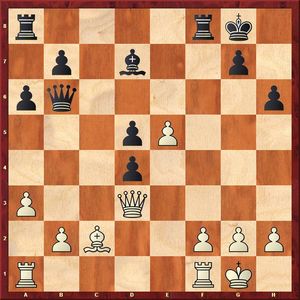
Until this moment the game proceeded in keeping with some intrinsic logic. However, after the next move of Black everything changed.
19...Rf5?
A lot more reliable is 19...Bf5! – a move that suggested itself. It is likely that Baadur was not happy about the ending that would arise after 20.Qb3 Qxb3 21.Bxb3, but let’s continue the line further: 21...Rad8 22.Rad1 (the immediate urge for White is to do away with the black pawns) 22...d3 23.f3 Kf7 24.Ba2 Ke6 25.Rfe1 Rc8! 26.Bb1 Rc2! with counterplay for Black.
Therefore stronger is 22.Rac1! with a stable edge for White. However, the position features a lot of fighting potential.
20.f4 (20.Rae1!?) 20...Bb5 21.Qxf5 d3+ 22.Rf2! Rf8 23.Bxd3! Rxf5 24.Bxf5

The tandem of rooks and a pawn are superior to the queen. A certain amount of initiative that Black possesses in this position would soon fizzle out if met with precise play by White. For example, 24...g6! 25.Bc2 Qe3 (25...Kg7 26.Re1) 26.Bxg6! d4 27.Rd1 d3 28.g3 Kg7 29.Bf5 a5 30.Kg2 Bc6+ 31.Kf1 Bb5 32.Rdd2 b6 33.Kg2 Bc6+ 34.Kh3 Bb5 35.b3 Ba6 36.a4 Kf7 37.Kh4! (37.Rg2 Bb7) 37...Kg7 38.Rg2! Kf7 (38...Bb7 39.Rxd3) 39.Rd1 Kg7 40.Rgd2+–.
In the game, however, Jobava simply blundered his d5-pawn.
24...Qe3? 25.Be6+
upon which he resigned immediately.
Well, the upheavals of the round nine haven’t introduced any changes in the overall standings of the tournament leaders. Six players go on competing for top honors, while Tomashevsky keeps looking at them threateningly them from afar.
The finale is coming soon...






















